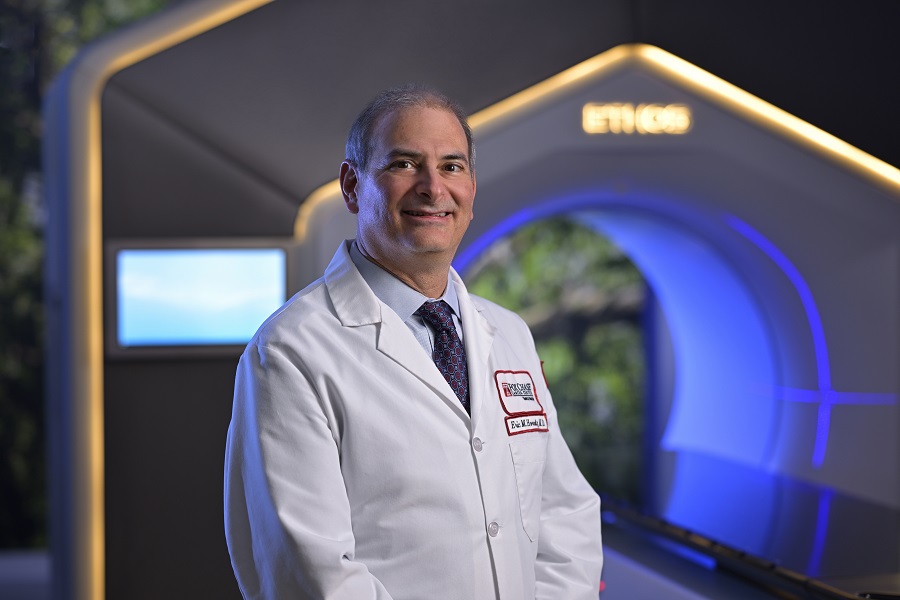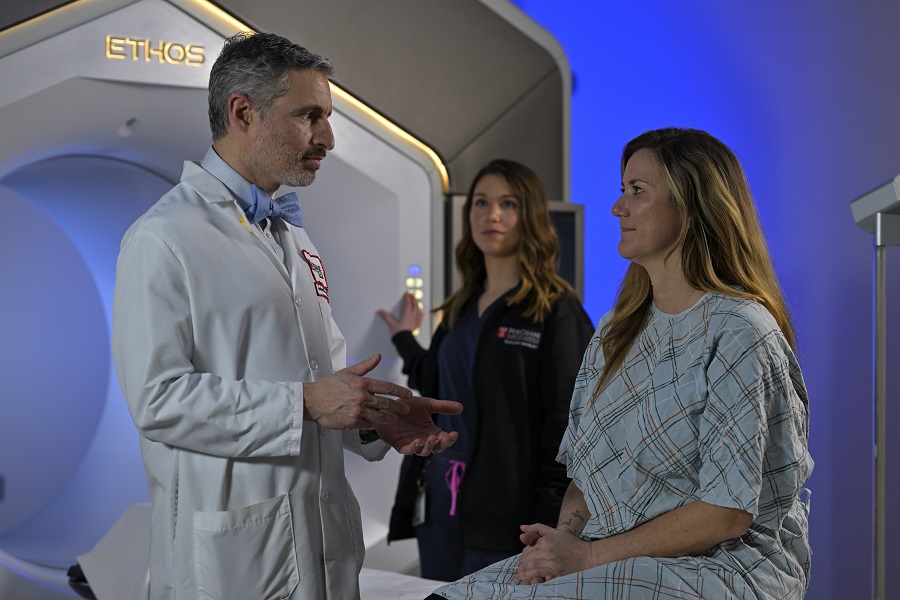This Philly Medical Team Is Using Promising New Technology to Target and Destroy Cancer Every Day Of Treatment

Dr. Eric Horwitz, chair of the Department of Radiation Oncology at Fox Chase
The fundamental tools of cancer treatment have largely been identified. Surgery, radiation, chemotherapy, and, most recently, immunotherapy form the key components of many treatment plans. So, when one of those critical tools takes a leap forward, physicians working in cancer treatment get excited. And that’s exactly how the radiation oncologists at Fox Chase Cancer Center in Philadelphia are feeling right now.
Radiation has always faced limitations. Ever since its adoption as a cancer treatment, the fundamental challenge has been clearly defined: How do you expose cancer cells to a sufficient dose to kill the cells without damaging surrounding, healthy tissue? Radiation oncologists face this multifactorial decision-making when calculating radiation dosages for patients.
“There are relatively few–not zero, but relatively few–cancers where we are able to increase the radiation dose to the optimal level to kill the cancer cells,” says Dr. Joshua Meyer, radiation oncologist at Fox Chase. “Often, we’re actually having to decrease the dose to limit side effects.”
Meyer is part of a Fox Chase team trying to change that dynamic. One of the main issues is that all cells, healthy or not, move within the body. Because of this, radiation oncologists must carefully limit the patient’s radiation dose to the cancer cells to limit collateral damage to surrounding tissue or organs. The problem with this approach is that effectiveness is also limited.
But in 2023, Meyer and other Fox Chase physicians started to explore an innovative form of radiotherapy technology—CBCT (cone-beam computed tomography)-based adaptive radiation therapy. With it, physicians gain more control over where they send the radiation dose. They can adapt their treatment plan to accommodate anatomical changes to the tumor and surrounding organs and tissues. If their current work is successful, they’ll be able to target cancer cells more precisely with radiation while minimizing damage to healthy cells, potentially sparking a revolution in cancer care and achieving better patient outcomes.
“We’re looking to do stuff that, when I was a resident nearly three decades ago, we had always dreamed about,” says Dr. Eric Horwitz, chair of the Department of Radiation Oncology at Fox Chase.

Dr. Joshua Meyer, radiation oncologist at Fox Chase
Tackling the Trickiest Cancers
The fact that cancerous cells can move during treatment might seem surprising at first, but it’s really a simple matter of how the body operates. The lungs expand, the stomach swells, and your bladder fills–all these simple changes push cancer tumors in different organs into different positions throughout the day. That problem is exacerbated by the fact that tumors can respond differently to treatment, and if the treatment is going well, a shrinking tumor can actually let healthy cells get into the radiation’s path.
That challenge becomes particularly significant when the tumor is clustered tightly in or near a critical or sensitive area adjacent to important normal organs. That describes pancreatic, lung, prostate, and head and neck cancer, to name just a few of the cancers that require the most careful targeting.
In the past, radiation oncologists had to work with one or two scans (CT, MRI, PET) done before the radiation therapy began. The physicians then worked closely with medical physicists and dosimetrists and spent hours developing precise treatment plans, which delivered the most appropriate dose of radiation to the cancer while sparing the adjacent normal organs as much as possible and keeping the radiation doses below safe levels to minimize side effects.
The radiation treatment plans are generated using special computer programs and can take days to complete. “We would push go on the computer and check the result when we came in the next morning. Because it took that long for the system to run,” Meyer says. “And then if we didn’t like it, we would have to do it again and come in the next day.”
The adaptive radiotherapy system treatment planning works in real-time, taking advantage of modern computing and extremely fast imaging with a CT scanner built into the linear accelerator (the machine that delivers the radiation treatment), to, in theory, scan and calculate. This combination of CT scanner, linear accelerator, and treatment planning software can generate sophisticated treatment plans in minutes, all while the patient is on the treatment table.
What is different with this treatment compared to non-adaptive radiation treatments is that now, patients will get a new treatment plan with every radiation treatment session. This new plan will be based on the exact position of the cancer and the normal organs next to the cancer. The radiation oncologist will compare the newly adapted treatment plan with the plan that was prepared before the patient begins treatment. Whichever plan, the adaptive or pre-plan, is better will be selected and used for each treatment. Each fraction of radiation will be delivered to exactly what is present each time.
Unlocking a Greater Potential
Horwitz and Meyer saw that the new technology could be revolutionary in the right hands. But the technology was complex, so they assembled an expert team to learn how to utilize it fully.
“Adaptive radiation therapy is harder to do than conventional radiation therapies. It’s more labor-intensive and more complex. It requires a specifically trained group focused on this technique,” Horwitz says. “We’re off to a great start because we have the resources to assemble a team specifically to deliver these adaptive treatments. We have nine Ph.D. medical physicists in the Department of Radiation Oncology at Fox Chase. In addition, we have our radiation therapists, medical dosimetrists, and the physicians who are all part of our adaptive team. And we planned and prepared and trained for six months prior to the arrival of this new technology.”
Now, the team is participating in a series of clinical trials sponsored by Varian, a Siemens Healthineers company, the maker of the innovative adaptive radiation therapy system. These studies will explore opportunities to safely increase patient doses for the cancers that will most benefit from the enhanced dosages, from pancreatic to head and neck cancer over the next few years. And the implications could be enormous.
“It’s an opportunity to transform what we do significantly,” Meyer says.
In addition to raising the likelihood of eradicating cancer cells while minimizing damage, there’s the potential to treat cancers otherwise considered too risky to treat with radiation. For example: cancers located near a kidney, when the patient only has one kidney, or lung cancer in a patient whose lung function has already been limited by smoking.
Treatment length may also decrease due to the more efficient dosage.
“This opens opportunities for more effective combinations of treatments while also allowing radiation to potentially fill in for surgery where surgery carries too great a risk,” says Meyers.
Unlocking the full potential of radiation doesn’t just help patients who can benefit from a curative approach. For patients suffering from metastatic cancer, adaptive radiotherapy treatment planning has the potential to make their cancer more controllable–by allowing radiation oncologists to target the key sources of metastatic cancer over a longer period while reducing side effects.
“If we can’t cure you, we can help you. Certain cancers have become almost chronic diseases. Three decades ago, they would’ve been fatal, but now you could live a long life with them,” Horwitz says. “There have been a lot of studies that show, for certain types of metastatic cancers, if you target one particular area where the cancer comes back repeatedly, you can delay it showing up somewhere else.”
In the near term, Fox Chase is planning an investigator-initiated clinical trial to explore the treatment of oligometastatic disease in the abdomen and pelvis, using adaptive radiotherapy to reduce side effects to the normal tissues adjacent to the cancer.
In the meantime, patients not participating in the trial already benefit from adaptive radiotherapy technology—with standard dosages—just delivered with hyper accuracy. But Horwitz hopes that before long, Fox Chase will lead a sea change in how we think about radiation treatment.
Right now, in the very first study offered by Fox Chase, investigators are studying men with early and intermediate-risk prostate cancer. The phase II multi-institutional study, sponsored by Varian, is “Daily Adaptive Stereotactic Body Radiation Therapy for Prostate Cancer with Urethral Sparing: A Prospective Trial Using an Individualized Approach to Reduce Urinary Toxicity (ARTIA-Prostate).”
“We hope that what we do in clinical trials this year will become standard next year and the following year. But this is a long-term project that will be ongoing,” Horwitz says. “And knowing that, we’ve focused on treating cancers that will have the biggest impact for the most people possible.”
This is a paid partnership between Fox Chase Cancer Center and Philadelphia Magazine


